817 Search Results for praactical teaching
October 8, 2014
by Carole Zangari -
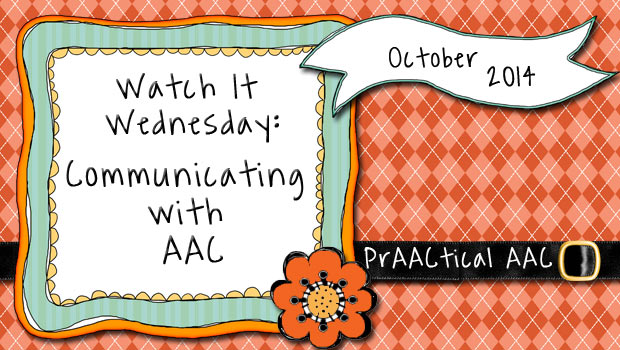
There is no better time that AAC Awareness Month to see and hear directly from people who use AAC. A lot of focus is on children and education, but this is a great reminder that no one is too old or too anything to learn to improve their communication skills. Thanks to Deanna Wagner, (who has done some terrific posts for us here, here, and here), and her clients at the Valley of the Sun School and Habilitation Center for making this video and sharing it with the rest of us.
September 22, 2014
by Carole Zangari -
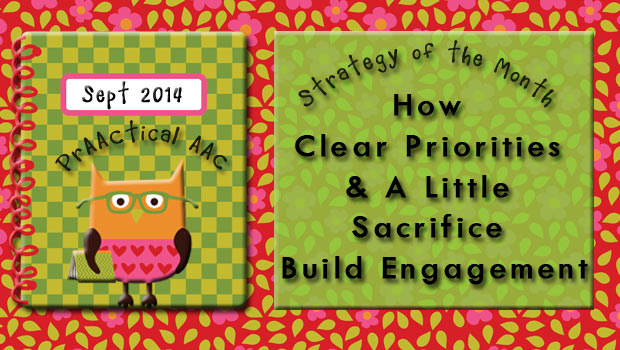
We can’t complete our thoughts on engaging AAC learners without a bit of conversation around the topic of priorities. Here’s the main idea: Go into each activity having a clear priority for what you want to achieve. Everything else become negotiable. As SLPs, sometimes we want it all. We want therapy activities where the AAC learner initiates communications, uses new vocabulary, creates novel sentences, experiments with new grammatical forms, and kicks some morphological butt. We.want.it.all. After a few decades of being an AAC practitioner, I think I’m finally learning that trying to have it all isn’t always the best option. It isn’t about what I want, it’s about what my client needs. Sigh. In this approach, we look at the lesson or activity and create our “Must Have List.’ For Mayra, a kindergartner just learning to use symbols for the first time, our lessons ‘must’ be engaging, have high pay-off... [Read More...]
September 18, 2014
by Carole Zangari -
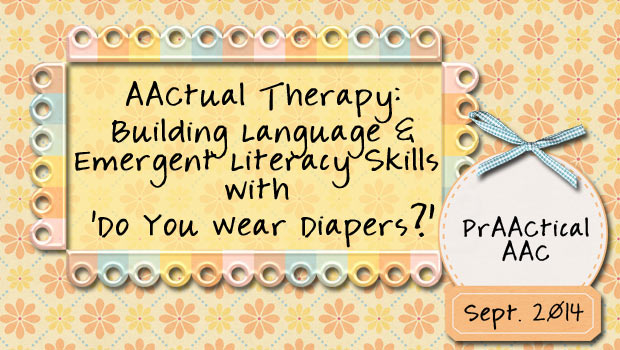
What’s more fun than using story books to teaching language to young children with AAC needs? Today, we hear from Kimberly Scanlon, an SLP practicing in New Jersey. Kimberley is is a devoted mom, wife and dog lover and blogs at Scanlon Speech and My Toddler Talks. She is the author of My Toddler Talks: Strategies and Activities to Promote Your Child’s Language Development and is finishing a unique picture and activity workbook, Learning to Read is a Ball. ::::::::::::::::::::::::::::::::::::::::::::::::::::::::::: Hold on to your undies, today we’re going to talk about poop, diapers, and the location of where various animals go potty. Sounds like a good time, right? Kidding aside, in this post I’m going to show you how to use this adorable picture book, Do You Wear Diapers? by Tanya Roitman to facilitate language and emergent literacy development in toddlers and preschoolers. What’s this book about? It’s a potty book! This adorable board book... [Read More...]
August 28, 2014
by Carole Zangari -
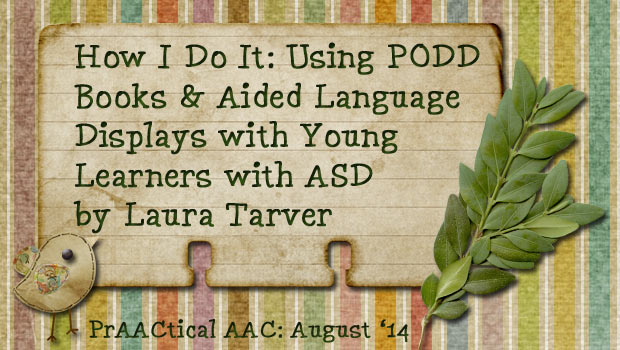
Today, we turn to the UK in a guest post by Laura Tarver. a London-based Speech and Language Therapist working with children with ASD and other complex needs. She previously worked in a primary school for children with ASD, where PODD and Aided Language Displays were introduced as part of a school wide approach in order to enhance the communication-friendly environment for all pupils. In this post, she shares how they used PODD books and aided language input to build the students’ communication skills. :::::::::::::::::::::::::::::::::::::::::::::::::::::::::::::::::: PODD (or Pragmatic Organisation Dynamic Display) communication books were developed in Australia by Gayle Porter, originally for children with cerebral palsy. As their use becomes more widespread throughout the world, practitioners are considering the benefits of using them with other clinical populations. Their structured organisation and emphasis on visual communication means that they are also a valuable tool for developing the communication of those with... [Read More...]
July 24, 2014
by Carole Zangari -
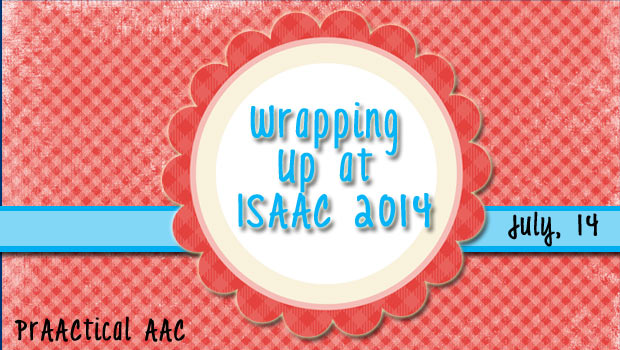
Today we wrap up the ISAAC 2014 Biennial Conference, where people who use AAC and people who support them through research, teaching, and direct services came together for one purpose: sharing. Yesterday, I had the privilege of presenting a 2-hour session with Dr. Gloria Soto from San Francisco State University. You can download our handout here or in the AAC e-Toolbox.
July 22, 2014
by Carole Zangari -
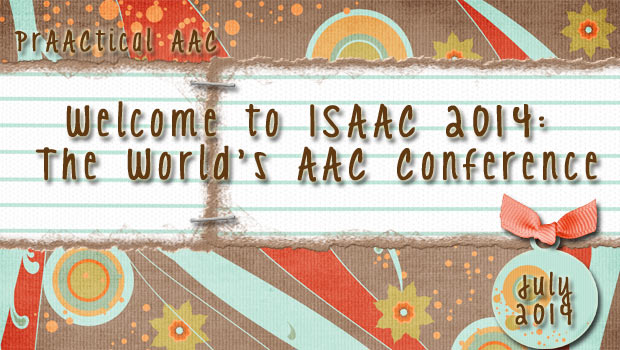
Welcome to ISAAC 2014! I know many of you wish you could be here in Lisbon learning along with me from the world’s top AAC researchers, practitioners, families, and consumers. What an exciting place to be! For those of you unable to make the trip, I encourage you to start planning and saving your pennies for the next ISAAC conference in 2016. In the meantime, I’ll try to do some sharing here to give you a peek at all of the AAC goodness happening here in Lisbon this week. My highlight so far was presenting with Jane Farrall. Both of us have a passion for teaching literacy to people with AAC needs, but in this presentation, our focus was on using literacy experiences to teach communication skills. You can check out our handout below or in the AAC eToolbox.
July 10, 2014
by Carole Zangari -
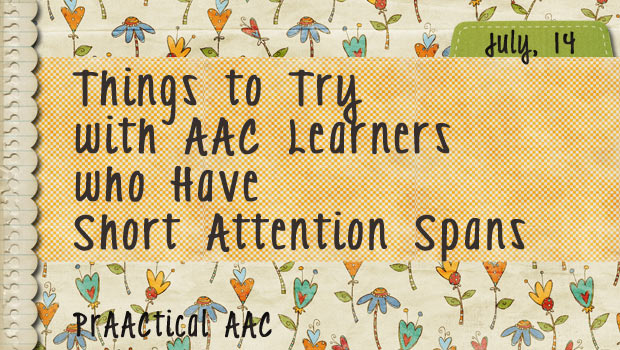
We love talking to AAC practitioners, hearing their stories, and picking up some tips along the way. Some conversations we love for the creative ideas or underlying passion. Others are memorable for less positive reasons. But still, they give us pause and challenge us to be better problem-solvers. “I love those ideas, but they won’t work with MY client: He doesn’t pay attention. He’s just not ready for all this. How do you expect me to teach someone with such a short attention span?” Glad you asked! First, don’t blame the learner. Like having short legs or frizzy hair, attention span is something over which some learners have little or no control. Their physiology is their physiology and they may not like it any more than we do. Use high-interest components in your therapy. The goals are the goals, but we can use things the client likes to make working on... [Read More...]
June 23, 2014
by Robin Parker -
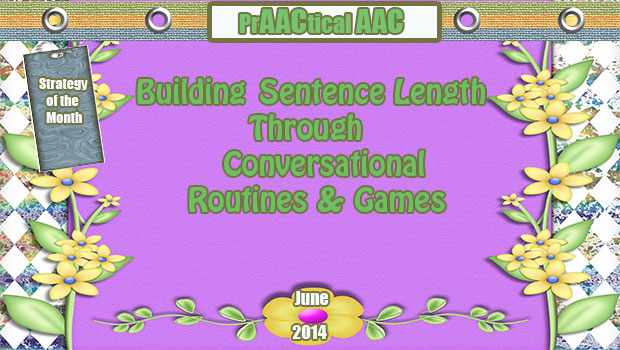
Building sentence length beyond the simple sentence level can be a lot of fun for those of us who love language. Additionally, and even more important, expanded sentences can provide communication impact and power to the communicator. Expanded sentences usually means moving from the simple to complex sentence. As Carole mentioned last week, we often begin with conjunctions like ‘because’, ‘but’, ‘so’, ‘if’, before’, after’. Here are some ideas for conversational routines and games that allow for frequent repetition with variety as well as strong communication power that will help with making it worthwhile to use longer sentences. “Pretty Please” Routine- This routine involves using ‘because’ to negotiate with longer sentences. This routine is reserved for requests that are possible but not always honored. In the case of teaching, we start with requests that can be honored if “pretty please because I worked hard or some other reasonable reason is... [Read More...]
June 16, 2014
by Carole Zangari -
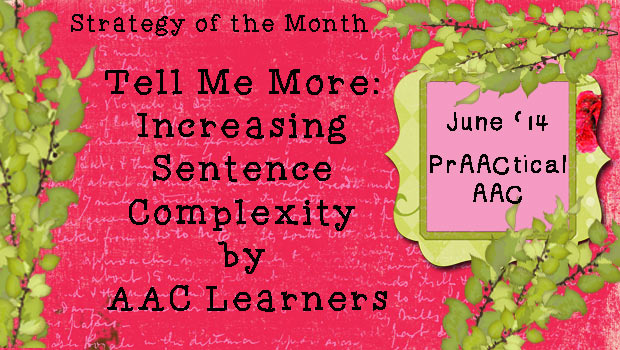
Expanding the length and complexity of sentences is something that SLPs love to work on well beyond the ‘early communicator’ phase, something we talked about a few weeks back. In today’s post, we’ll consider ways to build more complex utterances for learners who are gaining competence with their AAC systems but who still use language that is immature, imprecise, or overly simplistic. In many ways, this therapy is like language therapy for any other learner with delays in grammar, syntax, and morphology. Indeed, we sometimes forget to activate all that we know about language intervention when working learners who use AAC. We try to use that as a starting point and adjust for the AAC components as needed. Here are some of the things that we think about when planning therapy for AAC learners who are trying to strengthen their ability to speak in more complex sentences. Relate the language... [Read More...]
June 9, 2014
by Robin Parker -
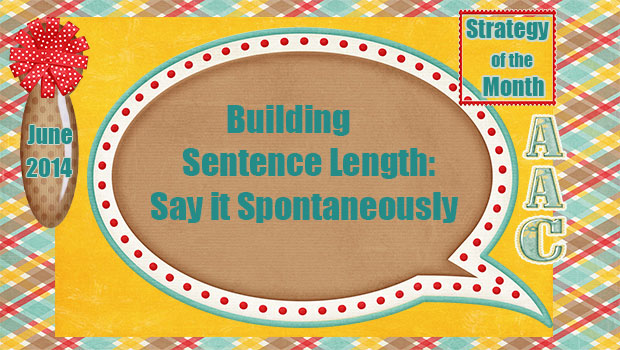
As beginning communicators start using single symbols to communicate, the next step immediately becomes to expand sentence length to two words, then three words, then more. Helping learners to use longer sentences spontaneously is the main goal. Teaching spontaneous use of longer sentences helps assure that those sentences can be used with many communication partners and in many contexts. A great facilitator strategy for helping to build sentences is ‘add a word’ or expansions and extensions. This was mentioned in last week’s post: Helping Beginning Communicators Expand Their Sentence Length but is further delineated below. What is it? ‘Add a word’ strategy is more formally called expansions and extensions. Expansions typically refer to adding a word with new conceptual knowledge while extensions add a word with new grammatical information. Expansions and extensions are a form of modeling and can be done both on a communication display as well as verbally. This... [Read More...]









